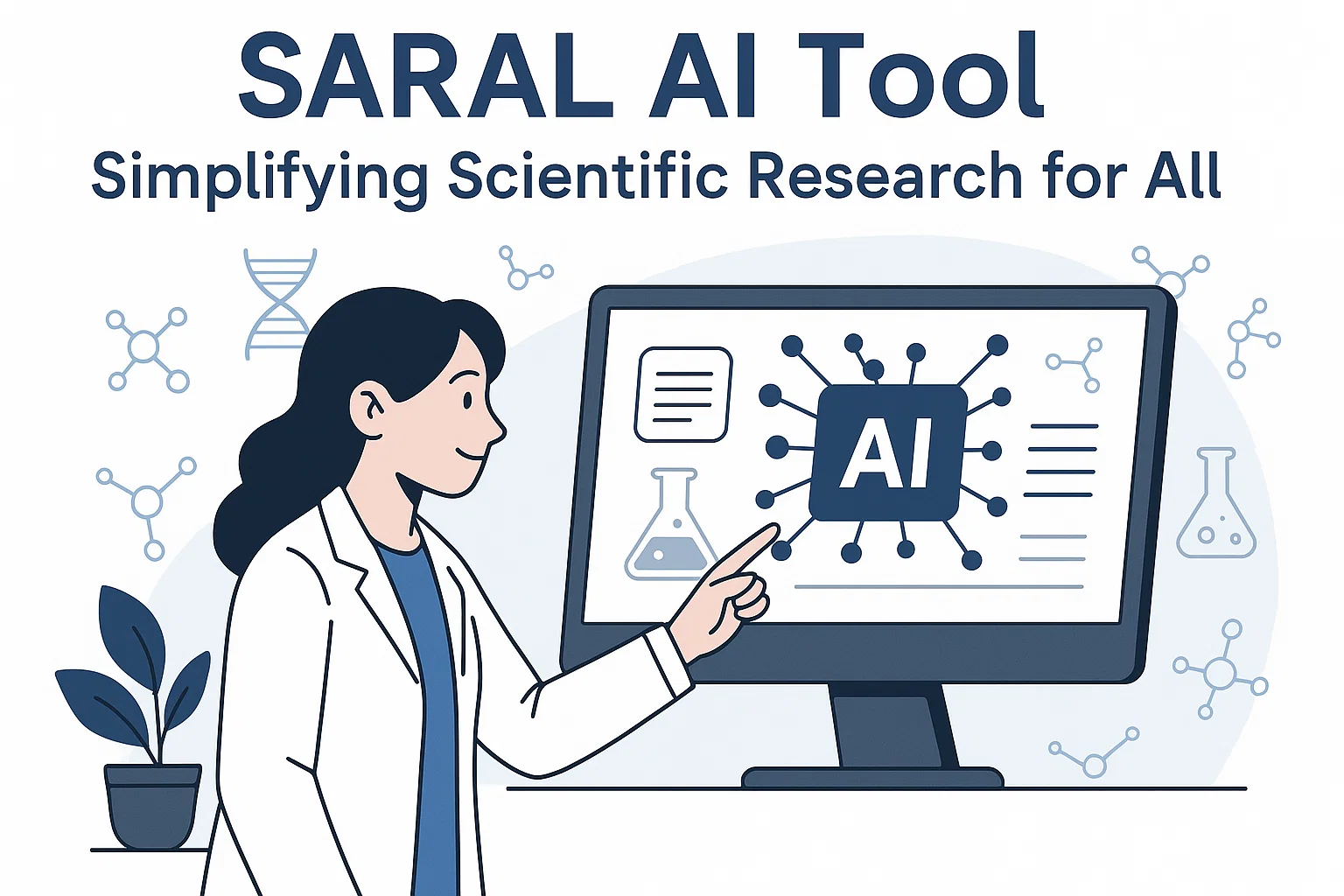SARAL AI Tool: Simplifying Scientific Research for All
The ANRF’s SARAL AI tool transforms complex scientific research into multilingual, multimedia-friendly formats. Learn how SARAL improves accessibility, outreach, and public engagement with science across India.
Context
The Anusandhan National Research Foundation (ANRF) has recently launched an innovative AI-powered tool named SARAL—Simplified and Automated Research Amplification and Learning. It is designed to make dense scientific research more accessible, enabling students, educators, and the general public to engage with complex scientific knowledge that was previously confined to elite academic circles.
What is SARAL?
SARAL stands for Simplified and Automated Research Amplification and Learning. Developed by IIIT Hyderabad under the guidance of ANRF, the tool leverages artificial intelligence to convert technical and dense scientific papers into layperson-friendly summaries.
The objective is straightforward yet transformative: to democratise access to cutting-edge research, enabling not just scientists but also students, professionals, and curious members of the public to understand and apply scientific knowledge. By doing so, it aims to foster a culture of curiosity, innovation, and informed decision-making across India.
/ciol/media/media_files/2025/07/29/ai-in-research-2025-07-29-11-53-43.jpg)
Challenges in India’s Research Ecosystem Addressed by SARAL
1. Language Barriers
A significant portion of research is published in English, which limits accessibility for non-English speakers. SARAL addresses this by supporting 11 Indian languages, allowing a much broader audience to engage with scientific findings without linguistic hurdles.
2. Accessibility
Many research papers are hidden behind paywalls or presented in highly technical formats. SARAL transforms these papers into free, editable, and multimedia-friendly formats—including slides, posters, and videos. This ensures that knowledge is not confined to journals but can be shared widely in classrooms, workshops, and digital platforms.
3. Outreach Deficit
Scientific breakthroughs often fail to reach the general public due to complex presentation and limited dissemination channels. SARAL bridges this gap, enabling research to reach social media audiences, classrooms, and non-academic communities, thereby enhancing public understanding and participation in science.
How SARAL Differs from Traditional Science Communication
| Feature | Traditional Communication | SARAL Tool |
|---|---|---|
| Format | Text-heavy journals | AI-generated videos, slides, podcasts |
| Language | Primarily English | Multilingual (11 Indian languages) |
| Audience Reach | Limited to academia | General public, students, educators |
| Technology Use | Minimal | AI-driven summarisation and translation |
| Accessibility | Often paywalled or technical | Free, editable, and user-friendly |
This shift from traditional journal-centric dissemination to multimedia, multilingual, and AI-assisted formats enables a wider reach and improves comprehension, particularly for younger audiences and those outside elite research institutions.
Alignment with ANRF’s Goals
The ANRF Act, 2023, envisions India as a global R&D leader, aiming to raise research spending to 2% of GDP with 70% private sector participation. SARAL aligns seamlessly with this vision by:
-
Democratising Research: Making scientific knowledge understandable and engaging for all segments of society.
-
Promoting Inclusivity: Reaching diverse linguistic and educational backgrounds, thereby reducing barriers to scientific participation.
-
Building Capacity: Empowering educators, students, and innovators with tools to engage with research, enhancing skills, and encouraging experimentation.
By complementing ANRF’s broader mission to foster interdisciplinary research, public-private partnerships, and grassroots innovation, SARAL also contributes to India’s Viksit Bharat 2047 goals—creating a knowledge-driven economy and promoting technological self-reliance.
Potential Impact
The launch of SARAL could have transformative implications for India’s research ecosystem:
-
Educational Empowerment: Students at school and university levels can now access simplified research, enhancing STEM education and fostering curiosity.
-
Policy and Decision Making: Policy-makers can use simplified research outputs to make evidence-based decisions without needing deep domain expertise.
-
Innovation and Entrepreneurship: By making research accessible, it can stimulate innovation and entrepreneurship, especially in startups and small enterprises leveraging scientific knowledge.
-
Public Engagement: Increased visibility of scientific research may encourage citizen science initiatives, public awareness campaigns, and greater societal participation in science and technology discussions.
Conclusion
SARAL represents a major step towards making scientific research inclusive, accessible, and actionable. By combining AI-powered summarisation, multilingual support, and multimedia outputs, it addresses the key barriers in India’s research ecosystem. With the backing of ANRF, SARAL not only facilitates learning and innovation but also strengthens India’s position as a global R&D leader in line with its long-term vision of Viksit Bharat 2047.
Subscribe to our Youtube Channel for more Valuable Content – TheStudyias
Download the App to Subscribe to our Courses – Thestudyias
The Source’s Authority and Ownership of the Article is Claimed By THE STUDY IAS BY MANIKANT SINGH





